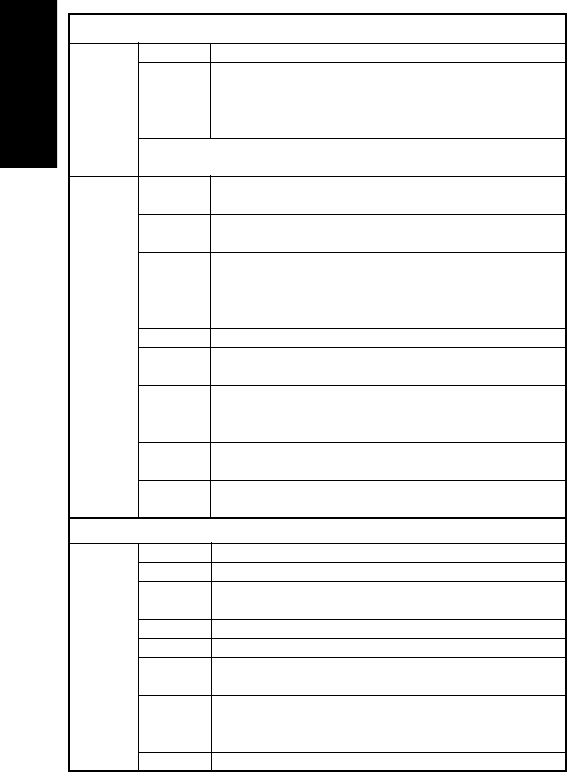
ENGLISH
8
AMP
MODE3 7 LVL+ Increases channel level volume
8 LVL- decreases channel level volume
After pressing the CH+ button, use the LVL+
and LVL- buttons to adjust the volume level of
each speaker channel.
Note: These level controls are for temporary adjustment,
so these setup is not memorized for each source.
PROCESSOR
1 VOL+ increases external decoder’s volume
This button is not used for AV9000.
2 VOL- decreases external decoder’s volume
This button is not used for AV9000.
3 6-CH 6 channel direct button
When the surround processor is connected to
the DIRECT IN JACKS, press this button to play
it.
4 BYP bypasses external processor’s decoding
5 SLEP sleep timer button
This button is used for setting the sleep timer.
6 DISP display off function
When this button is pressed, the display is
turned off.
7 MODE surround mode select button
This button is not used for AV9000
8 PHNO phono function button
This button is not used for AV9000.
TUNER
BAND 1 FM FM band button
2 AM AM/MW band button
3 LW long wave band button
This button is not used for AV9000
4 BAND selects radio band button
5 MODE mono/stereo/muting mode selector button
6 TIME time display button
This button is not used for AV9000
7 F/P frequency or preset channel display select
button
This button is not used for AV9000
8 SCAN preset scan button
, PAGE buttons
These buttons are used to select any 1 of the 4 pages of 8 functions
for each DIRECT button, as explained above.
. FUNCTION buttons
These buttons are used for selecting the input function. Press one of
these buttons twice within 2 seconds.
⁄1 VOLUME UP (+) AND DOWN (-)
These buttons are used to raise and lower the main system volume
level.
⁄2 TEN KEYPAD
They are useful for tuning a pre-set radio station and setting a station
name.
⁄3 M (MEMO) button
This button is used to enter the tuner preset memory numbers and
station names.
⁄4 C (Clear) button
This button is used to cancel certain memory or programming
operations.
⁄6 CURSOR buttons
The cursor buttons can be used to navigate within on-screen menus.
These buttons are unavailable when the mode is set to DSS, TV or
DVD.
⁄7 MUTE button
This button can be used to mute the sound temporarily.
⁄9 LIGHTING button
This button is used to activate the back-lit LCD screen and back-lit
keys.
Useful Functions with the Remote Control Unit
• Source direct
Press AMP button .. Press DIR D2 on page2 to make higher quality
Hi-Fi sounds. When this function is selected, the signals are
transmitted by bypassing the tone control circuitry so that they can be
reproduced with higher quality.
Notes:
The surround mode is switched automatically to STEREO when
the source direct function is turned on.
The source direct function is available with a digital source when
the input signal is the PCM.
If a Dolby Digital signal or DTS signal input to AV9000, in this
mode output from AV9000 will be muted.
• Attenuate
Press AMP button .. Press ATT D3 on page2 to attenuate the
analog AUDIO signal selected with the FUNCTION buttons. When
the analog input signal is too great and the voice distorts even by
throttling the AV9000 VOLUME control, turn on the function. “ATT” is
displayed when this function is activated.
The signal-input level is reduced by about half. Attenuate is invalid for
use with the output signal of “REC OUT” (TAPE, CD-R/MD, VCR1 and
DSS/VCR2 output).
This function is memorized for each input function.
• Multi room
Press AMP button .. Press MLTI D8 on page2 to switch the unit to
multi room mode. “MULTI ROOM” appears in the display.
• Display off
Press AMP button .. Press DISP D6 on page4, the display is turned
off and the display off indicator lights up ( DISP ). To turn the display
ON again, perform the previous procedure.
• FM mode
Press TUNER button .. Press FM D1 on page 1 to select the auto
stereo mode or mono mode when the FM band is selected. The AUTO
indicator lights in the auto stereo mode.
• Tuner band selector
Press TUNER button .. Press BAND D4 on page 1 to switch
between FM mode and AM mode of the tuner.
Tuner band is changed in the following sequence.
FM → AM → FM → ...


















